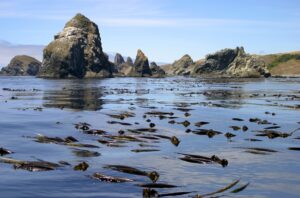medinites.com/deephistory
Pacific Migration, Existence, and Paradox: A Deep History
Let's begin by diving deeply (pun intended) into the history of anthropological understandings regarding the settlement of the American continent.
Surf and/or Turf
Sample from Kelp Bed
Oregon Islands National Wildlife Refuge
Pacific Northwest, USA, North America

A standard high school education likely told the story of the peopling of the Americas like this: the formation of massive glaciers during the last ice age had caused the sea level to decline, creating a so-called “land bridge” connecting Siberia to North America; this area, known as Beringia, provided dry land expanse for early peoples to cross into the American continent as they migrated out of Asia.
Within the archaeological field, those in support of this migration-via-Beringia camp often pointed to the broad chronology of an early Paleolithic Clovis culture as evidence in support of their movement. By the turn of the millenia, however, recent discoveries [see bonus material] in sites ranging from Monte Verde to Oregon put the chronology to put the so-called Clovis First theory in doubt.
[Bonus Material: Academic Debate and Discovery]
Archaeological evidence that pre-dated (and thus stood in contra to) Clovis First was bountiful even before the onset of the twenty-first century; for more information, read a recent expose in Smithsonian magazine on Jacques Cinq-Mars (and his ostracism within the field following his promotion of a pre-Clovis discovery) and the intolerance of the archaeological-anthropological discipline towards challenges of their status quo.